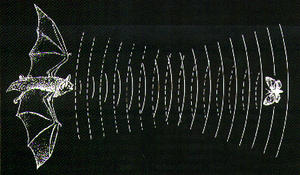Ultrasound navigationNature inspires advances in ultrasound technology
Sonar and ultrasound, which use sound as a navigational device and to paint accurate pictures of an environment, are the basis of many technologies, including medical ultrasound machines and submarine navigation systems; when it comes to more accurate sonar and ultrasound, however, animals’ “biosonar” capabilities still have the human race beat – but not for long

Biosonar's advantage lies in rapid return-signal processing // Source: ekac.org
Sonar and ultrasound, which use sound as a navigational device and to paint accurate pictures of an environment, are the basis of many technologies, including medical ultrasound machines and submarine navigation systems.
When it comes to more accurate sonar and ultrasound, however, animals’ “biosonar” capabilities still have the human race beat.
An American Friends of Tel Aviv University release reports that this advantage may not last for much longer. In a new project that studies bats, dolphins, and mole rats, Professor Nathan Intrator of Tel Aviv University’s Blavatnik School of Computer Science, in collaboration with Brown University’s Professor Jim Simmons, is working to identify what gives biosonar the edge over human-made technologies. Using a unique method for measuring how the animals interpret the returning signals, Professor Intrator has determined that the key to these animals’ success is superior, real-time data processing. “Animal ‘echolocations’ are done in fractions of milliseconds, at a resolution so high that a dolphin can see a tennis ball from approximately 260 feet away,” he says, noting that the animals are able to process several pieces of information simultaneously.
Their research, which has been reported in the Journal of the Acoustical Society of America and presented at the 2010 and 2011 MLSP conferences, could lead to cutting-edge navigation systems and more accurate medical imaging.
Detecting “shape” from sound
Biosonar animals send ultrasonic sounds called “pings” into the environment. The shape of the returning signals, or echoes, determines how these animals “see” their surroundings, helping them to navigate or hunt for prey. In a matter of tens of milliseconds, the neurons in the animal’s brain are capable of a full-scale analysis of their surroundings represented in three dimensions, with little energy consumption. Even with the aid of a supercomputer, which consumes thousands of times more energy, humans cannot produce such an accurate picture, Professor Intrator says.
With echolocation, a bat can tell the difference between a fly in motion or at rest, or determine which of two fruits is heavier by observing their movements in the wind.
Intrigued by the quality of the natural world’s biosonar over its man-made equivalents, Professors Intrator and Simmons set out to study how biosonar animals perform echo location so quickly and accurately. Using an electronic system, they altered the frequency and noise levels of the echo returned to the animal.
By manipulating the echo, the researchers could determine what factors of the returning signal reduced an animal’s ability to correctly analyze the returns. This in turn led to a better understanding of how the returning echoes are represented and analyzed in the animal’s brain.
A more accurate view of the human body
The release notes that Professors Intrator and his fellow researchers have created mathematical models, involving machine learning and signal processing, that improve man’s ability to interpret the echoes. This will lead to more accurate echo localization and better resilience to background noise.
Once researchers gather more information about animal interpretation of biosonar, they will be able to mimic this technology for better ultrasound and sonar systems, says Professor Intrator. “Animals explore pings with multiple filters or receptive fields, and we have demonstrated that exploring each ping in multiple ways can lead to higher accuracy,” he explains. “By understanding sonar animals, we can create a new family of ultrasound systems that will be able to explore our bodies with more accurate medical imaging.”
This could provide a variety of benefits to the medical field, such as earlier detection of defects in embryos or non-invasive detection of cancer tumors. Unlike an MRI or CT machine, which are large, expensive to operate, and often use dangerous radiation, the new generation of ultrasound machines could be used in a doctor’s office at a fraction of the cost. The research could also benefit military reconnaissance efforts both underwater and underground.
